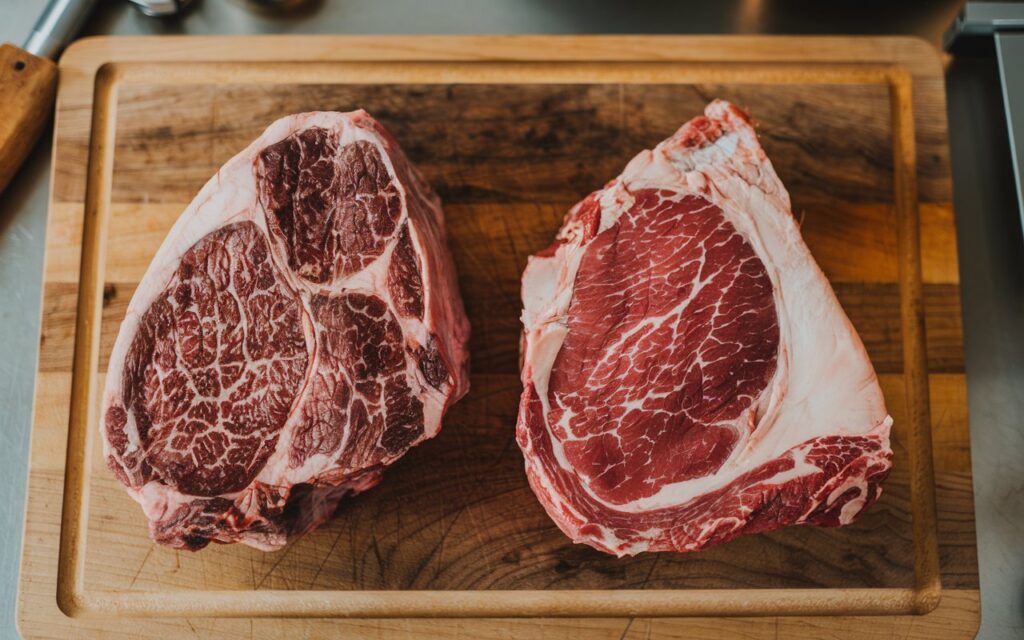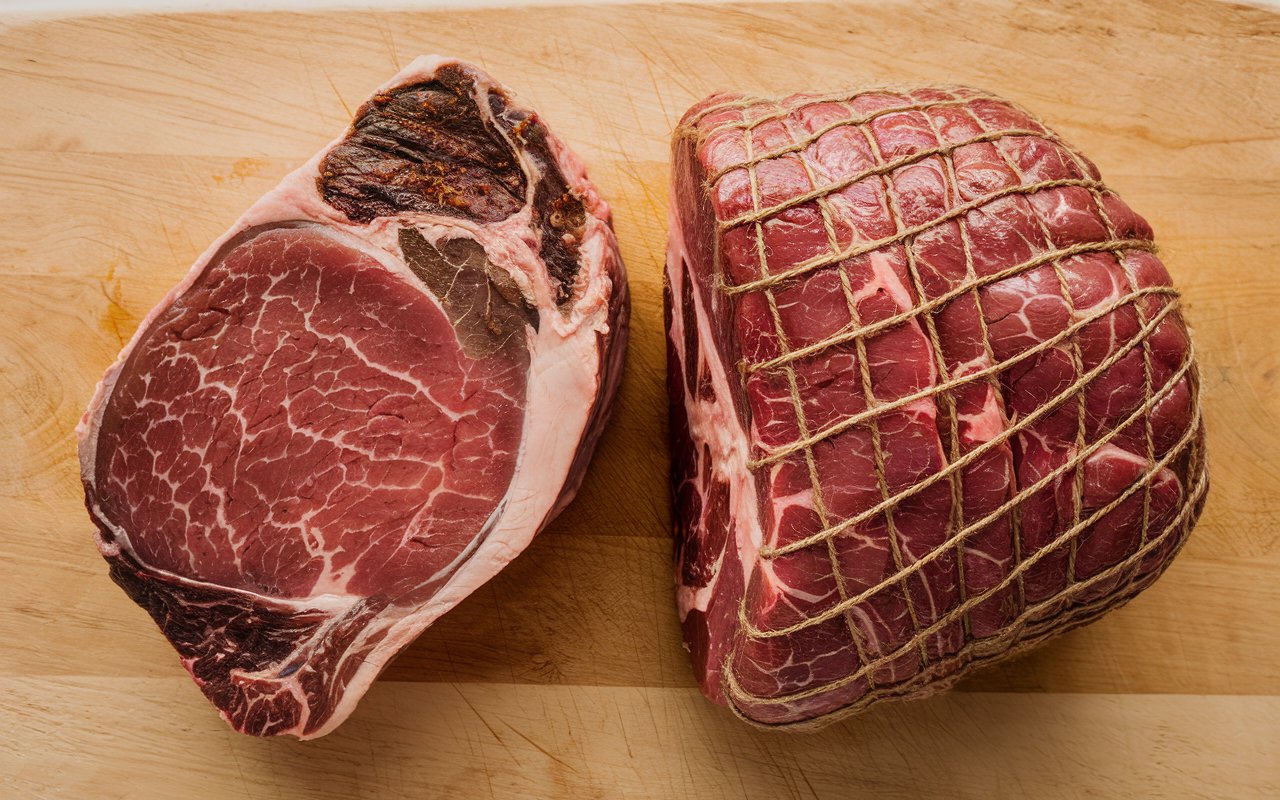Which is better arm chuck or rump roast?
Choosing between arm chuck and rump roast can be a challenge, especially when crafting the perfect meal. These two cuts of beef offer distinct flavors, textures, and cooking potential. Understanding their differences will not only improve your culinary skills but also help you select the best cut for your specific dish. This comprehensive guide dives deep into the world of arm chuck and rump roast, exploring their qualities, uses, and cooking tips to answer the ultimate question: Which is better, arm chuck or rump roast?
Which is better arm chuck or rump roast?
The Origin of Arm Chuck
Arm chuck, a cut from the cow’s shoulder, boasts incredible marbling. The rich veins of fat that run through this cut make it a standout choice for slow-cooked meals. The shoulder area bears much of the cow’s weight, leading to a cut that’s naturally flavorful and moderately tough. However, when cooked low and slow, the connective tissues break down, resulting in buttery tenderness.
Characteristics of Arm Chuck:
- Location: Sourced from the forequarter, near the shoulder blade.
- Marbling: High fat content for rich flavor.
- Primary Cooking Method: Moist-heat methods like braising or slow cooking.
The Origin of Rump Roast
Rump roast is taken from the hindquarters, specifically the upper part of the round. As a working muscle, this area is leaner, offering less marbling but more structural integrity. Although slightly firmer than arm chuck, the lean quality makes rump roast an excellent choice for those seeking a healthier, low-fat option.
Characteristics of Rump Roast:
- Location: Derived from the rear end of the cow, above the back legs.
- Leanness: Minimal fat, requiring precise cooking to avoid dryness.
- Primary Cooking Method: Dry roasting, or slow cooking to tenderize.
Arm Chuck vs. Rump Roast: A Detailed Comparison
Tenderness
Arm chuck is generally more tender due to its abundant marbling. When slow-cooked, the fat melts and enriches the meat, creating a melt-in-your-mouth texture. On the other hand, rump roast is leaner and can feel firm if not cooked properly. Using techniques like marinating or sous vide can help enhance its tenderness.
Flavor Profile
The rich fat content in arm chuck makes it bolder and beefier in taste. It’s ideal for dishes that require depth of flavor. Conversely, rump roast has a subtle taste, making it versatile for recipes with strong marinades or spices.
Cooking Versatility
- Arm Chuck: Excels in slow cooking methods such as braising, which transforms its connective tissue into a silky texture.
- Rump Roast: Shines when roasted to medium-rare and thinly sliced. It can also be cubed and used in hearty stews.
- How to Cook Beef Stews Like a Pro
- Perfect Marinades for Rump Roast
- Slow Cooker Recipes to Try Tonight
Nutritional Comparison
Choosing between these cuts often depends on dietary goals. Here’s how they compare:
| Nutrient | Arm Chuck (4 oz) | Rump Roast (4 oz) |
|---|---|---|
| Calories | 280 | 190 |
| Total Fat | 22g | 8g |
| Protein | 20g | 28g |
| Cholesterol | 75mg | 70mg |
Insights:
- Arm chuck has higher calories and fat, making it ideal for indulgent meals.
- Rump roast is leaner, suiting those watching their fat intake or seeking a high-protein option.
Best Dishes for Arm Chuck and Rump Roast
Perfect Dishes for Arm Chuck
- Pot Roast: The marbling ensures tenderness, while the beefy flavor shines with carrots, onions, and potatoes.
- Beef Stew: The fat content keeps the meat moist, even after hours of simmering.
- Shredded BBQ Beef: Perfect for sandwiches, tacos, or sliders.
Perfect Dishes for Rump Roast
- Roast Beef: Best cooked to medium-rare and served with au jus or horseradish cream.
- Beef Jerky: The leanness of rump roast makes it ideal for dehydration.
- Beef Stroganoff: Thinly sliced rump roast pairs perfectly with creamy mushroom sauce.
How to Cook Arm Chuck and Rump Roast to Perfection
Cooking Arm Chuck
- Slow Cooking: Place arm chuck in a slow cooker with broth, wine, or tomato-based sauces for maximum flavor.
- Dutch Oven Braising: Sear the meat on all sides, then simmer it in a heavy pot with vegetables and liquid for a hearty meal.
- Internal Temperature: For tender, shreddable beef, aim for an internal temperature of 190–200°F.
Cooking Rump Roast
- Marinating: Use a marinade with acidic components like red wine vinegar, lemon juice, or soy sauce to tenderize the meat.
- Roasting Tips: Preheat the oven to 325°F and cook the roast until it reaches an internal temperature of 135°F for medium-rare.
- Resting Time: After cooking, let the meat rest for at least 15 minutes to redistribute its juices.
Pros and Cons: Arm Chuck vs. Rump Roast
| Factor | Arm Chuck | Rump Roast |
|---|---|---|
| Tenderness | High (when slow-cooked) | Medium (requires care) |
| Flavor | Bold and beefy | Subtle and versatile |
| Cooking Time | Long (slow cooking) | Shorter (roasting) |
| Fat Content | High | Low |
| Price | Budget-friendly | Slightly more expensive |
Expert Tips for Choosing the Right Cut
When to Choose Arm Chuck:
- You’re making a stew, pot roast, or shredded beef.
- You prefer a rich, flavorful dish.
- You’re working on a tight budget.
When to Choose Rump Roast:
- You want a leaner cut for roasting or slicing.
- You’re preparing a special occasion meal.
- You plan to marinate the beef or pair it with strong sauces.

The History and Popularity of Arm Chuck and Rump Roast
Arm Chuck Roast: A Culinary Staple
The arm chuck roast has long been a cornerstone of traditional home cooking, especially in American households. Its origins trace back to the practice of utilizing affordable cuts of meat that, with the right cooking techniques, could transform into tender, flavorful dishes. During the 20th century, as slow-cooking appliances like crockpots gained popularity, the arm chuck roast became a household favorite. Families embraced this cut for its ability to deliver hearty, satisfying meals with minimal effort.
The robust flavor and affordability of arm chuck roast also made it a favorite among chefs in rustic and comfort food-focused restaurants. Over time, dishes like pot roast became synonymous with family gatherings, holidays, and Sunday dinners, cementing the arm chuck roast’s place in culinary tradition.
Rump Roast: From Humble Beginnings to Modern Sophistication
Rump roast, on the other hand, has had a different journey. Historically, rump roast was seen as a tougher, leaner cut primarily used for large roasts served at communal gatherings. However, as culinary techniques evolved, cooks discovered how to tenderize this cut and enhance its flavor, making it more versatile than originally perceived.
In modern kitchens, rump roast has gained popularity among health-conscious cooks seeking leaner cuts of beef. Its adaptability has led to its inclusion in recipes ranging from classic roast beef sandwiches to creative sous vide dishes. Today, it’s not just a budget-friendly option but also a symbol of refined cooking when prepared with precision.
Why Their Popularity Endures
Both arm chuck and rump roast hold special places in culinary traditions due to their versatility, affordability, and ability to feed large groups. Whether you’re slow-cooking a chuck roast for a casual family dinner or preparing a rump roast for a formal event, these cuts offer flexibility that appeals to both novice cooks and professional chefs. Their continued popularity reflects the enduring value of learning how to work with different cuts of beef to achieve maximum flavor.
Common Mistakes to Avoid When Cooking Arm Chuck and Rump Roast
Mistakes When Cooking Arm Chuck Roast
- Not Cooking Long Enough
One of the most common errors when preparing arm chuck roast is undercooking it. Due to its connective tissue and fat content, this cut requires extended cooking times to achieve its signature tenderness. Rushing the process can leave the meat tough and chewy.Solution: Use slow cooking methods like braising or crockpot cooking. Aim for at least 6-8 hours at low heat to allow the collagen to break down. - Skipping the Sear
Another mistake is neglecting to sear the meat before slow cooking. Searing locks in flavor and creates a caramelized crust that enhances the dish’s overall taste.Solution: Sear the roast on all sides in a hot skillet before transferring it to the slow cooker or oven. This extra step adds depth to the flavor. - Using Insufficient Liquid
Arm chuck roast needs moisture during cooking to tenderize properly. Without enough liquid, the meat can dry out, even with its marbling.Solution: Add beef broth, wine, or tomato-based sauces to the pot. Ensure the liquid covers at least half of the roast.
Mistakes When Cooking Rump Roast
- Overcooking
Rump roast, being lean, is prone to drying out if cooked too long. Unlike arm chuck, this cut lacks the fat to stay moist under extended cooking times.Solution: Roast at moderate temperatures and monitor the internal temperature closely. Remove the roast from the oven at 135°F for medium-rare and allow it to rest. - Skipping the Resting Period
Cutting into rump roast immediately after cooking can cause the juices to escape, leaving the meat dry.Solution: Always let the roast rest for 15-20 minutes before slicing. This allows the juices to redistribute and keeps the meat moist. - Neglecting Marinades or Rubs
Rump roast’s leanness means it can lack flavor if cooked without seasoning. Simply roasting it without preparation can result in a bland dish.Solution: Marinate the roast overnight in a mixture of oil, vinegar, herbs, and spices. Alternatively, use a flavorful dry rub before roasting to enhance the taste.
Key Takeaways
By avoiding these common mistakes, you can elevate your cooking skills and maximize the potential of both cuts. Whether you’re preparing a succulent arm chuck roast or a perfectly sliced rump roast, understanding what not to do is just as important as following a recipe.
FAQs: Which is better arm chuck or rump roast?
Which is more tender, arm chuck or rump roast?
Arm chuck is typically more tender because of its higher fat content. Slow cooking further enhances this tenderness.
Which is better for roast beef, rump roast or chuck roast?
For traditional roast beef, rump roast is preferred because of its lean structure and fine texture.
Can you substitute arm chuck for rump roast in recipes?
Yes, but expect differences in flavor and texture. Arm chuck will add more fat and richness, while rump roast remains leaner.
What is the healthiest cut between the two?
Rump roast is the healthier choice due to its lower fat content and higher protein levels.
Conclusion: Which Is Better, Arm Chuck or Rump Roast?
Deciding whether arm chuck or rump roast is better ultimately depends on your recipe, cooking method, and personal preference. Each cut of beef brings unique qualities to the table, and both have their ideal roles in creating delicious, satisfying meals.
If you’re looking for a cut that offers bold, rich flavors and tender, melt-in-your-mouth textures, arm chuck roast is your go-to. Its marbling makes it ideal for slow cooking methods like braising or stewing. Whether you’re preparing a comforting pot roast, hearty beef stew, or shredded beef for tacos, the arm chuck delivers exceptional results every time. Additionally, its affordability makes it a budget-friendly option for feeding a family or hosting a dinner party.
On the other hand, rump roast shines in dishes where leaner meat is preferred. Its fine-grained texture and low-fat content make it an excellent choice for recipes like classic roast beef, deli-style sandwiches, or even beef jerky. While slightly less tender than arm chuck, the rump roast absorbs marinades beautifully and pairs well with robust seasonings. With proper preparation—like marinating or slow roasting—it transforms into a flavorful, elegant centerpiece for any meal.
When to Choose Arm Chuck
- You want tender, juicy meat with a bold flavor.
- Your recipe involves slow cooking, braising, or shredding.
- You’re working with a tight budget but still want a flavorful dish.
When to Choose Rump Roast
- You need a leaner cut of beef for roasting or slicing.
- You’re preparing a dish that benefits from marinades or rubs.
- You’re looking for a healthier option with less fat content.
Both cuts excel when paired with the right cooking techniques. The arm chuck is a champion in slow-cooked, hearty dishes, while the rump roast offers lean elegance perfect for carving and plating. To truly enjoy the best of both worlds, experiment with each cut and adapt them to your favorite recipes.
Ultimately, your choice between arm chuck and rump roast should be guided by the dish you’re making and the flavor profile you want to achieve. By understanding their unique qualities, cooking methods, and ideal uses, you can confidently incorporate these cuts into your culinary repertoire. Whether you’re preparing a comforting family dinner or an impressive meal for guests, these versatile cuts of beef are sure to satisfy.
When in doubt, remember: the key to unlocking their full potential lies in careful preparation and thoughtful cooking techniques. Both arm chuck and rump roast have a place in your kitchen, and mastering their preparation will elevate your skills as a cook, ensuring every meal is memorable.

